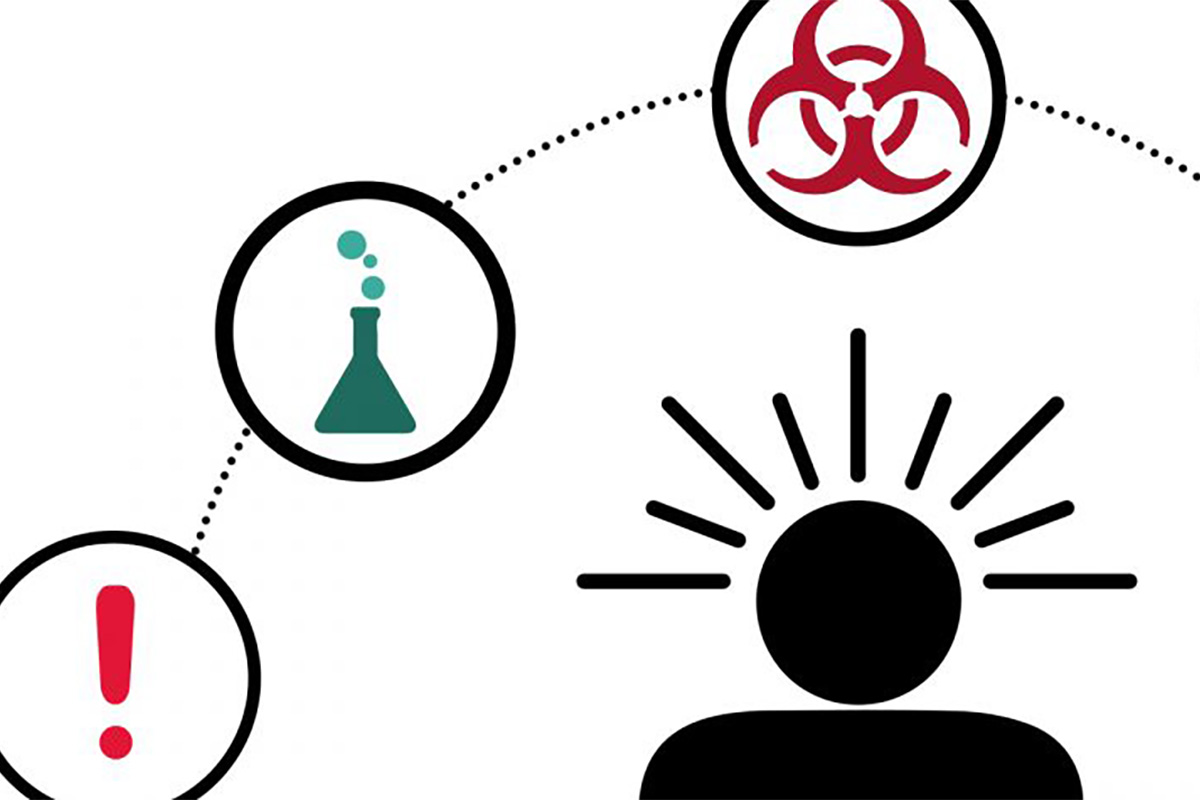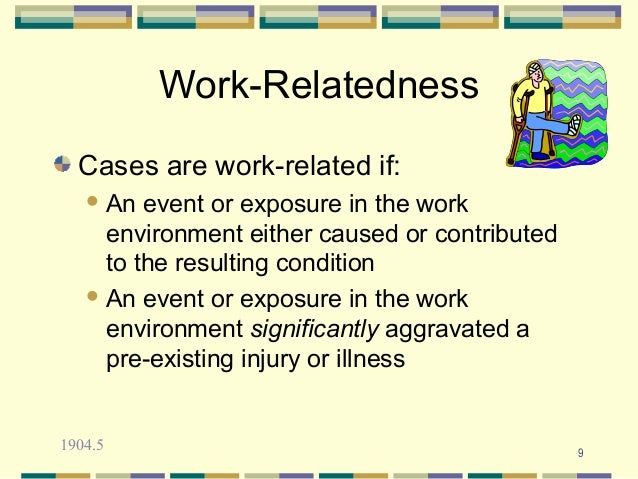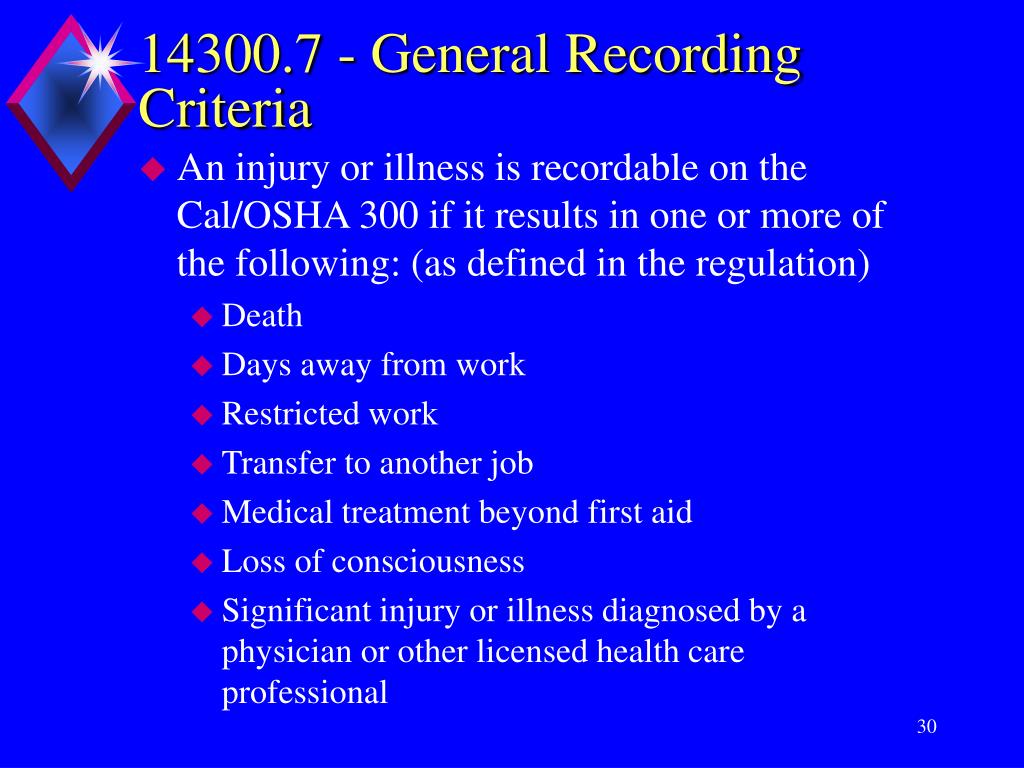Table of Content
That must be recorded are those severe enough to warrant medical treatment beyond first aid. The Basics of Incident Investigations Webinar Without a proper incident investigation, it becomes difficult to take preventative measures and implement corrective actions. Watch this on-demand webinar for a step-by-step process of a basic incident investigation, how to document your incident investigation findings and analyze incident data, and more. Employers must summarize the time, location, and people involved for each incident.
Within seven calendar days or less, determine whether the incident meets the OSHA recordkeeping requirements. An example of a non-work-related injury is if an employee runs to pick up the work phone during work hours and trips, which results in an injury to the employee. Another example is when an employee hears their child crying, gets up to tend to their child and is injured in the process. Although both injuries occurred during work, they did not directly relate to the performance of the job.
The Essential Guide to OSHA SDS Requirements
The former applies if the employee already sometimes worked from home as part of the normal work routine, while the latter would apply if they did not. OSHA requires employers to make sure employees have and use safe tools and equipment and that such equipment is properly maintained. Employers are also required to establish or update operating procedures and communicate them to employees so that they will follow safety and health requirements. In addition to any training requirements imposed by specific standards, employee training is one way for an employer to meet its general responsibility under the OSH Act for preventing violations.
“Solving health and safety problems in the workplace requires injury and illness records to be accurate and transparent,” Assistant Secretary for Occupational Safety and Health Doug Parker said in an agency statement. Recordkeeping of work-related injuries and illnesses can maximise occupational safety, so long as they’re done accurately and the OSHA recordkeeping requirements are met. The information recorded on the forms can be beneficial for employers, workers and OSHA to better understand the hazards in the workplace and come up with strategies to eliminate them. Lone Worker Guide Lone workers exist in every industry and include individuals such as contractors, self-employed people, and those who work off-site or outside normal hours.
Fatal Work Injuries in 2021 Up Almost Nine Percent from 2020
For information on recording cases of work-related COVID-19 during the COVID-19 Pandemic, see OSHA's COVID-19 Regulations page or OSHA’s COVID-19 page. The mission of EHS On Tap is to provide clear, relevant, actionable information on topics that matter to EHS professionals in podcast form through engaging and insightful interviews with experts and thought leaders. The OSHA Recordkeeping Advisor presents questions and relies on responses to determine the appropriate course of action. If the Advisor does not address the circumstances of a particular case, please contact OSHA or obtain expert advice.
The point of these strict requirements is to track illnesses and injuries so that you can prevent them in the future. Recording these helps you identify patterns and correct dangerous or hazardous conditions. In other words, you won’t record every COVID-19 case that appears in your workplace.
Why Employee Engagement is the Key to Unlocking Safety Program Performance
You should have a remote worker policy drafted and implemented so there is documentation of your expectations as an employer. It also helps provide documentation that may be needed to rebut a complaint from OSHA. The difference between the two is that one consists of office work and the other involves using an area of the home for employees to perform the work of the employer.
Efficient EMS-OHSMS Manual and Procedures are fully integrated and related forms are included to meet both the ISO and OHSAS requirements. S requirements for preventing accidental release of energy or accidental start-up of equipment. You will learn what documents to have in place, including a written lockout/tagout plan, and how to implement it.
If an employee works at multiple establishments instead of a single one, the employer would need to assign them to an establishment for recordkeeping purposes. OSHA's health and safety inspection program is directed primarily toward industrial and commercial establishments and construction sites. We do not ordinarily conduct inspections of home-based workplaces, although from time to time we have visited private homes or apartments to investigate reports of sweatshop-type working conditions in the garment industry and other businesses. We would also investigate work-related fatalities occurring in home-based workplaces.

Are you an environment, health, and safety professional with something to contribute to your professional community? On December 16, Parker also issued a statement following a report from the Bureau of Labor Statistics that fatal workplace injuries increased in 2021. Following inspections at six warehouse facilities, the e-commerce company now faces up to $29,000 in proposed penalties. If a physician or licensed healthcare worker prescribes the worker to stay at home for a certain number of days, but they choose to come back to work prematurely, then you still need to record the day count as prescribed by the physician. Describe the case as specifically as possible on the form, including the exact location and circumstances of the occurrence.
The Occupational Health and Safety Administration has played an active role in reducing work-related injuries, illnesses and fatalities through OSHA recordkeeping rules since the early 1970s. As part of its regulatory efforts, OSHA maintains and updates recordkeeping rules that outline employers’ responsibilities following an on-the-job accident. Depending on the industry you’re in and the number of employees on your payroll, you may be required to keep detailed injury and illness records on file. Of course, it can be hard to tell which rules apply to your organization, and whether you need to submit your OSHA forms electronically.
One way of distilling these take-aways is to realize that the employee’s home environment is, by default, their home. OSHA has reinforced this position in guidance documents such as letters of interpretation issued over the years. If an employee’s fingernail was punctured and became infected by a needle from a sewing machine used to perform garment work at home, the injury would be considered work-related. However, in the case of home-based worksites, employees would be involved only where they had freely consented to the provision of assistance requested by the employer, and then only within the parameters defined above.
OSHA says that if they work for you — in any capacity, including “day-to-day supervision” — then a recordable injury needs to go on your 300 log. One of the most common mistakes is recording every incident in an attempt to avoid a fine. Adding too many non-recordable injuries to the log can raise your incidence rate, which can lead to more OSHA inspections and even cause your insurance rates to grow. You may even struggle to land contracts if it looks like you have a poor safety record.

Perhaps the best known of these is the OSHA 300 log, which records the details of injuries and illnesses that occur at your workplace. In this LOI, a correspondent explained that they were a federal contractor whose employees work at several hundred remote locations operated by clients. The correspondent wanted to know if each site operated and controlled by a client where their employees were assigned was considered an “establishment” of the company for recordkeeping purposes.
But now suppose that someone is working at home, but hearing the phone ring, leaps from his seat to answer it, trips and sustains an injury requiring medical treatment. That’s because the employee was not in the process of working while he sustained his injury. In determining the effectiveness of the employer's efforts to establish and maintain a workplace safety and management program. Specifically, you state that your company will be placing some of its sales executives in home office environments. You state that the home office is generally a single room within the home of the sales executive that would have a desk, chair, file cabinet, business telephone, desktop or laptop computer, printer and a fax machine. You ask several specific questions that would apply specifically to your sales executives, as well as general questions that could apply to many other types of home work situations.


No comments:
Post a Comment